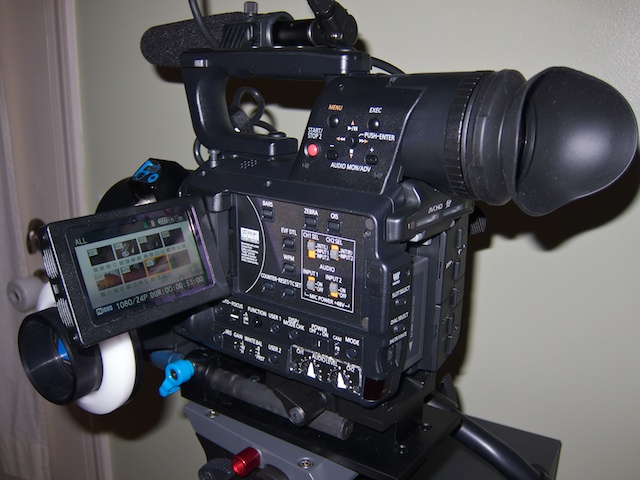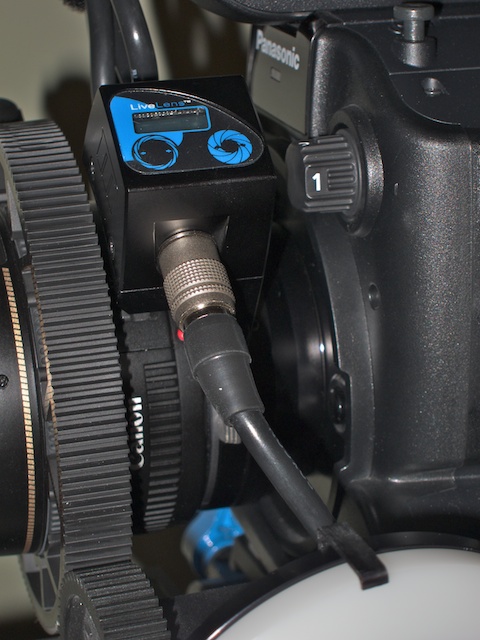AF100 first impressions
posted by Jeff | Saturday, April 21, 2012, 9:07 PM | comments: 0I pulled the trigger on buying a Panasonic AF100 last week. Nothing announced at NAB last week was interesting (or affordable) enough for me to consider an alternative. I've been wanting something that can do video "cinema style" that wasn't a DSLR for a long time, and I just haven't been satisfied with what I've been able to get out of the 7D.
My criteria was simple enough. It had to cost less than $10k (otherwise, I would've bought a Canon C300, which is way over that). It had to have proper audio connections and monitoring, SDI output, a reasonably video camera-like form factor, records to cheap media, and most importantly, the ability to use Canon lenses.
I first saw the AF100 in person at NAB last year, and what drew me to it was the similarity in terms of controls to the HVX200, which I've had now for about six years. The HVX has been a great video camera for me, with the biggest problems being the crazy expensive recording media and the fixed lens with small sensor that makes it look like, well, video. Not that there's anything wrong with that, because it's fantastic as an ENG camera, but it doesn't let you get particularly artistic with how you shoot.
The AF100 has a Micro Four-Thirds (MFT) mount and sensor size, which is a standard that's a bit smaller than full-frame or "crop" sensor DSLR's. It's actually 1/4 the size of a full-frame DSLR, so a 50mm lens is essentially like a 100mm, in 35mm DSLR terms. (I kind of hate that "conversion" theory, because a 50mm lens is still a 50mm lens in this case, it's just that the camera only sees part of what the lens is capable of.) There are adapters for practically anything ever made, and there's a lot of enthusiasm around old eBay'd manual Nikon lenses in particular. Using my Canon lenses is trickier because you need a special mount that can operate the aperture of the lens, since it's all electronic, but fortunately it's a problem that Redrock Micro already solved with the cinema adapters that they've sold for years. It's a really nice piece of precision gear, too.
The camera itself is much lighter than the HVX, in part because it uses a lot of that weird composite material instead of metal, and also because it doesn't have a tape machine or a 3-CCD prism. At first I thought that was a cheap feeling, until I messed with it a bit, and now I'm thankful for the lightness. The only thing I found that felt cheap was the control nipple for navigating menus. Everything else, like lens mount, the LCD and viewfinder hinges, the battery lock, etc., are all really solid.
The menu system is still kind of ghetto compared to offerings from other companies. This is true for Panasonic's consumer gear, too. Things are kind of weird to find, though the things most important to you have buttons and dials, so it's not a huge issue.
I got a really cheap 14-42mm MFT lens, just so I could have something that could go really wide for outdoor landscape shots. I think it only opens up to f/3.5 when you're wide, so it's not a great lens for indoor or shallow depth of field. Still, it's handy and solid even inside for shooting video of my son or my cats or whatever. If you use it in 1080/30p or 720/60p, it will even autofocus for you. When you're in manual mode, because it's a native MFT lens, it also talks to the camera and shows you the focus distance on screen.
The real magic, however, is using my Canon lenses. While they can't go as wide with the smaller sensor, they score the image I was really after. My least expensive lens, a non-L 50mm f/1.4, looks really outstanding, and surprisingly sharp when it's wide open. The camera has something called focus assist, which will make the edges of anything in focus glow red. That's an awesome feature, because focusing in HD without a bigger monitor is not always easy. It also does zebra at a user-set percentage so it's super easy to catch over-exposure. I also plugged in my 24-105mm f/4 L, and it looks just as amazing as it does on my still cameras. Opening it to f/4 doesn't make super shallow DOF, but it still looks pretty great.
Exposure is really easy to deal with, in part because it has built-in neutral density filters. The lowest gain setting is ISO 200, and it's really clean. Open up a lens, however, and you'll blow out everything without the ND filters. This was another one of the issues with the DSLR shooting, that you needed ND for every lens you had, or you had to put them in a matte box. That's fine if you're shooting a movie, but a lot harder when you're running around shooting documentary style. It will go up to ISO 3200, which I tried, and it doesn't look horrible, just not great. Actually, hooked up to my TV via HDMI, it's not bad at all, but recorded with the AVCHD codec, the compression isn't great for noise. That's where an external recorder (with that SDI port I wanted) would come in handy. I don't think that's something I truly need, however, until I'm shooting a proper long-form film.
I can't tell you much about the image quality, because all I've done is shoot the cats. However, when Philip Bloom posted this short film over a year ago, shot on a prototype of the camera, I was pretty sold even then.
So far, no huge negatives. Like I said, the noise in the shadows at higher ISO's doesn't compress very well, but it's not horrible, and it can be minimized in post. I'm a little annoyed that Panasonic subtly changed the battery mount, so you can't use the batteries that the HVX uses. Jerks.
I hope to get out to the zoo with my long lens and see what kind of animal porn I can shoot. I was hugely dissatisfied with what I shot on the 7D a few weeks ago. Animals do cool stuff, as do kids who are excited about animals.
Here's the LiveLens mount, with its aperture setting buttons:
Comments
No comments yet.


